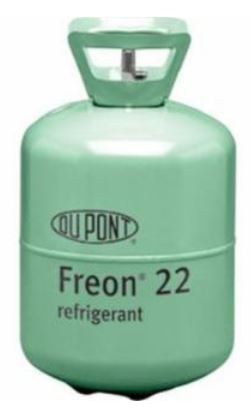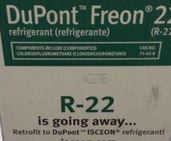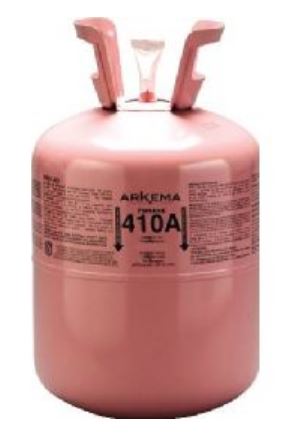Refrigerant 22 Phase Out
Most heat pumps and air conditioners manufactured prior to 2010 use refrigerant 22 (also known as Freon 22, R22, R-22, F-22, HCFC 22) as the coolant. It is an HCFC compound comprised of several basic chemicals, monochlorodiflouromethane. It has been widely used in the United States and around the world for HVAC and refrigeration applications since the 1960's. It was very safe and very affordable.

As far back as the 1970's scientists determined that some of the chemicals used in this refrigerant have a damaging effect on the ozone layer of our planet. The depletion was reportedly very substantial and so a plan was devised in 1987, a collaborative effort by many nations, that among other things included a mandate to eventually stop using R-22 (and all HCFC refrigerants) altogether, along with all CFC refrigerants such as R-12. A phase-out schedule was developed that mandated new types of ozone-friendly refrigerants be used in the future instead. That plan has been slowly implemented over the years and now the end of the phase-out schedule is finally upon us. They stopped manufacturing R22 systems in 2010 and they ultimately stopped manufacturing and importing R22 refrigerant for servicing purposes of existing systems in 2020. There are still limited stockpiles of old stock and reclaimed R22 available but the cost makes it impractical in most cases for usage at this point.
 |
Air conditioners and heat pumps manufactured after January 1, 2010 use a HFC refrigerant called R-410A. It has a zero ozone depletion potential, but it is however a greenhouse gas, so it isn't entirely environmentally friendly, but much more friendly than R-22. It was considerably cheaper for many years, however now this refrigerant is also being phased out and the costs are rapidly rising. See below for updated information.

Since R-22 is no longer being manufactured or imported into the USA, this has imposed a considerable hardship for people who still have a refrigerant 22 system and eventually may need a recharge. The availability of the refrigerant has become extremely low and the price has become extremely high (basic laws of supply and demand). There has been considerable misinformation publicized lately that is misleading and dishonest regarding the availability of freon 22. Some companies are telling their customers that this freon has been outlawed and they should replace their system immediately. The freon has NOT been outlawed! The only thing that has been outlawed is the manufacture or importation of new refrigerant. They may continue to use their R22 system as long as they wish. Existing inventories of R22 refrigerant are still very much legal to be sold and used, as well as salvaged freon from old systems may also be reclaimed and reused as many times as possible. R-22 is only practical at this point for one specific purpose. If you have a system that has a long term very small leak and the system requires 1 lb or less to recharge each year or every other year, this may be a good candidate for the use of R-22 if you can find a servicer who still has it.
If your R-22 system needs a major repair, such as a large refrigerant leak that is repairable, the most practical option if you wish to have the system repaired is to use a substitute refrigerant, and there are many still readily available. The substitues are approximatelty half or less the cost of R-22. The one downside to the use of a substitute refrigerant is that it changes the performance characteristics of the heat pump or air conditioner slightly. Generally it reduces the capacity by 5 to 10%, which means the system will run longer to give the same level of cooling or heating. It does however still make it feasible in some cases to service an R-22 system without having to replace it.
Refrigerant 410A Phase Out
Most heat pumps and air conditioners manufactured after 2010 use refrigerant 410A as the coolant. It is an HFC compound comprised of difluoromethane and pentafluoroethane. It was the answer to the ozone problem at that time but now it has created a new problem of its own. It is a greenhouse gas which apparently contributes to global warming the scientists say. R-410A is now being phased out and all new equipment manufactured after January 1, 2025 will have to comply with new refrigerant regulations for low GWP (global warming potential). Unlike the previous transition to R-410A in 2010 where all manufacturers agreed to utilize the same refrigerant, this new transition involves two refrigerants, namely R-454B and R-32. Each manufacturer has made their own decision as to which refrigerant to use.
For those who still own an R22 system they must convert to a substitute refrigerant if their system needs a full or substantial refrigerant charge and they do not want to replace the system or they cannot afford it. For those who have a R-410A system the refrigerant will still be available for servicing for many years, however gradually the supply will be reduced in accordance with the phase out schedule mandated by the EPA. In the meantime expect the price of R-410A to gradually keep getting higher and higher as the production phase out progresses . Ultimately R-410A will suffer the same fate as R-22.
.
